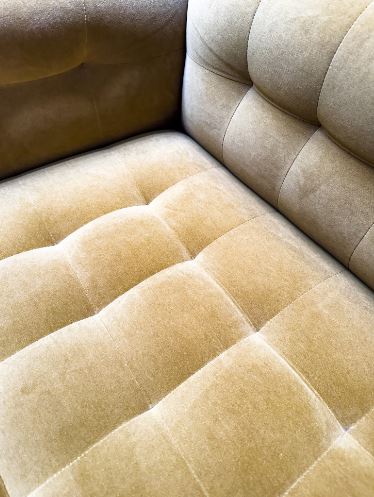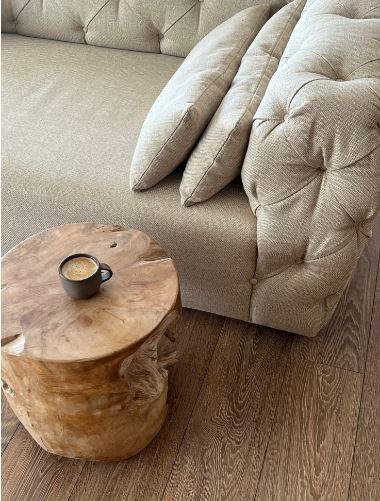

In this article, we’ll explore how to reupholster the fabric of your sofa. Sofas that have been used for years in our homes can wear out, the fabric may fade, or the style might no longer fit with our décor. So, what should we do in this situation? Instead of throwing it away, have you thought about transforming it? Reupholstering your sofa not only provides an economical solution but can also be an opportunity to create a design that reflects your style and adds a unique touch to your home.
Reupholstering is one of the most effective ways to bring an old piece of furniture back to life with a fresh new look. You can give it a contemporary, minimalist vibe, or create a warm, inviting farmhouse atmosphere with rustic details. The choices are entirely up to you!
In this guide, you’ll discover how to transform your old sofa step by step, from fabric selection to color coordination, foam replacement to sewing details. You’ll get tips for each stage to help you get one step closer to your dream sofa.
Remember, one of the cornerstones of sustainable living is reusing and repurposing what we already have. Reupholstering your sofa is a perfect opportunity to contribute to the environment and create a stylish living space!
But first, let’s understand what reupholstering is…

Photo by everdrop GmbH on Unsplash
Reupholstering is one of the most effective ways to give your old furniture a second life. Essentially, it involves removing the old fabric and applying a new one. However, the process isn’t just about changing the fabric. Reupholstering also offers a chance to review the frame, internal padding, and overall structure of your furniture. If the frame is still strong and functional, this method allows you to transform your furniture instead of buying new.
Sofas, chairs, armchairs, or ottomans… any piece of furniture you love but is now outdated or worn can be revitalized through reupholstering. You can completely change its style with a new fabric — turn a classic chair into a modern piece or transform a plain chair into a bold, patterned statement piece.
Now, let’s dive into the steps…
• Upholstery fabric (add an extra 1-2 meters for safety)
• Upholstery foam or fiber (if padding is worn out)
• Seam ripper
• Upholstery staple remover or flat screwdriver
• Heavy-duty stapler and staples
• Fabric scissors
• Sewing machine (or thick needles and strong thread)
• Upholstery thread
• Chalk or fabric marker
• Measuring tape
• Pliers
• Zippers or Velcro (for cushion covers)
• Screwdriver or wrench (to remove legs/arms)
• Dust cover (optional, for the bottom of the sofa)

Photo by AXP Photography on Unsplash
Before you begin the reupholstering process, one of the most important things to do is to document your sofa’s current condition. Take clear photos from the front, back, sides, and, if possible, from underneath. This simple yet effective step will save you a lot of trouble later on.
These photos also create a “before” archive for your project. Once the transformation is complete, doing a “before & after” comparison will not only motivate you but also add a professional touch when documenting your work, especially if you decide to share it on social media.
Remember, the most successful projects always start with good planning. Taking a few minutes for this photo session will protect you from potential confusion and time loss later.
If possible, disassemble the sofa. Remove all loose cushions, armrests, and legs. Then, using a seam ripper and staple remover, carefully begin removing the upholstery fabric. Label each piece with tags such as “left arm inside,” “back panel,” etc., to avoid confusion when cutting the new fabric.
Pay attention to how the fabric is layered and stapled. This will be important when reassembling the sofa. Typically, the first layer is a dust cover or burlap, followed by foam or fiber, and the outermost layer is the main upholstery fabric. Take close-up photos and label the layers as needed.
Now it’s time to check the frame. Is it squeaking? Is it wobbling? Reinforce any weak connections with wood glue or screws. If the springs on the bottom are sagging, consider replacing them with new zigzag springs or jute strips.
Old foam often becomes yellowed, flattened, or crumbled. Cut new foam for the seat and back cushions, and wrap it with fiber for added softness. You can also add extra fiber to the armrests or certain parts of the frame for a more comfortable sitting experience.
Use the old fabric as a template by laying it flat on the new upholstery fabric. Trace the shapes with chalk and carefully cut out the pieces. Remember to label each piece. For patterned fabrics, make sure the designs align at the seams.
Use the old cushion covers as templates and sew the new ones. Typically, a simple box or envelope form is sufficient; don’t forget to add a zipper or Velcro to one side. If your fabric is washable, be sure to pre-wash it to avoid shrinking.
Reupholster the sofa in reverse order of how you removed the fabric. Start with the interior sections (back inner surface, inner armrests) and then move to the outer surfaces. Pull the fabric taut but don’t stretch it too much. Work from the center outwards, smoothing out any wrinkles.
Want to make a statement? Add decorative details like piping (welting). Or, for a classic, elegant look, try tufted button details. These touches will give your sofa a professional and personalized appearance.
Once all visible fabric is upholstered, you can staple a new dust cover to the bottom if desired. Then, reattach the sofa legs and secure everything back into place.
Place your newly reupholstered sofa in its spot and complete the look with decorative cushions or a throw blanket. You’ll be amazed at how your furniture not only transforms, but how it can change the entire look of the room.

Photo by Kateryna Horska on Unsplash
• Choose durable fabric for high-traffic areas — like twill, canvas, or performance fabrics.
• Pay attention to the direction of patterns before cutting.
• Take your time: Reupholstering takes time, and working in stages produces the best results.
• Use fabric protectors: After the job is complete, protect your fabric with a spray like Scotchgard to increase its longevity.
I hope this article helps you in your reupholstering journey. Enjoy your newly transformed sofa! Looking forward to seeing you in my next project. Stay tuned…